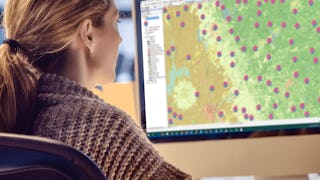The "Mastering Geospatial Analysis with QGIS" course employs a multi-disciplinary approach, covering essential aspects of geospatial analysis and QGIS software through nine structured modules. Module One introduces learners to QGIS, encompassing installation, QGIS 3.0 basics, and interface exploration including toolbars, panels, and plugins. Module Two focuses on practical geospatial data handling within QGIS, covering shapefiles, vector and raster data styling, and attribute management using calculators and selection tools. Module Three explores cartographic techniques such as coordinate systems, projections, and map creation including choropleth and graduated symbol maps. Additionally, it includes data integration tools like basemaps, GPS data handling, and measurement tools. Module Four delves into georeferencing and digitization methods for toposheets and online sources like Open Street Maps and Google Earth. Advanced spatial analysis techniques like buffer and overlay analysis are detailed in Module Six, while Modules Seven to Nine cover satellite data handling, terrain analysis, and advanced mapping and application development using QGIS and tools like Qfield and BIM integration. Join us in mastering QGIS for geospatial analysis and applications development, preparing to excel in this dynamic field.


Mastering Geospatial Analysis with QGIS
This course is part of Geospatial Techniques for Engineers Specialization

Instructor: Subject Matter Expert
4,267 already enrolled
Included with
(34 reviews)
Recommended experience
What you'll learn
Learn QGIS basics, data formats, and practical skills for handling vector/raster data and using tools like Field Calculator.
Master map styling, georeferencing, and digitization, including creating choropleth maps and integrating GPS data.
Explore advanced spatial analysis, satellite data classification, terrain modeling, and geospatial application development with QGIS.
Skills you'll gain
Details to know

Add to your LinkedIn profile
9 assignments
See how employees at top companies are mastering in-demand skills

Build your subject-matter expertise
- Learn new concepts from industry experts
- Gain a foundational understanding of a subject or tool
- Develop job-relevant skills with hands-on projects
- Earn a shareable career certificate

There are 9 modules in this course
This module introduces the fundamentals of QGIS (Quantum GIS), a popular open-source Geographic Information System software. Learners will be guided through the installation process of QGIS 3.0, exploring its features and graphical user interface (GUI) components such as toolbars, panels, and plugins.
What's included
8 videos3 readings1 assignment1 discussion prompt
This module focuses on practical skills for working with geospatial data in QGIS. Learners will learn to download and work with shapefiles, including styling vector and raster data. The module also covers handling attribute data using tools like the Field Calculator and selecting features within QGIS.
What's included
7 videos1 assignment1 discussion prompt
This module covers cartographic techniques and tools available in QGIS for map representation and styling. Learners will explore coordinate systems, projections, and create various thematic maps such as choropleth, graduated symbol, heat maps, and dot distribution maps. Additionally, the module covers map layout techniques and essential data integration and analysis tools within QGIS.
What's included
11 videos1 assignment1 discussion prompt
This module focuses on georeferencing and digitization techniques using QGIS. Learners will understand the process of georeferencing toposheets, including downloading and setting transformation parameters. They will also explore digitization techniques for creating point, polyline, and polygon datasets from toposheets.
What's included
11 videos1 assignment1 discussion prompt
This module focuses on advanced techniques for digitizing and georeferencing spatial data from online sources using QGIS. Learners will explore methods for digitizing point, polyline, and polygon datasets from OpenStreetMap and Google Earth images. The module covers downloading and georeferencing Google Earth images, and using the QuickMapServices plugin for accessing map data.
What's included
9 videos1 assignment1 discussion prompt
This module explores advanced spatial analysis techniques available in QGIS. Learners will delve into buffer analysis methods including multi-distance buffers, overlay analysis techniques, and network analysis using tools like the ORS (OpenRouteService) plugin. The module equips learners with skills to perform sophisticated spatial analyses for diverse applications.
What's included
9 videos1 assignment1 discussion prompt
This module focuses on acquiring and classifying satellite data using QGIS. Learners will explore various satellite data downloaders including USGS, Copernicus, NASA Earth Data Search, and Bhuvan. The module covers supervised classification techniques using the Maximum Likelihood Algorithm, unsupervised classification methods such as K means clustering, and temporal analysis techniques for change detection.
What's included
14 videos1 assignment1 discussion prompt
This module covers terrain analysis and surface modeling techniques using QGIS. Learners will explore elevation and slope analysis, hillshade, aspect, contour generation, watershed analysis, surface analysis, viewshed analysis, and profiling and cross-sectioning techniques for detailed spatial analysis and visualization.
What's included
10 videos1 assignment1 discussion prompt
This module explores advanced topics in geospatial mapping and application development using QGIS. Learners will learn techniques for extracting building footprints, creating 3D maps, and developing web and mobile maps. The module also covers integrating QGIS with Building Information Modeling (BIM) for creating digital twins.
What's included
8 videos1 assignment1 discussion prompt
Earn a career certificate
Add this credential to your LinkedIn profile, resume, or CV. Share it on social media and in your performance review.
Instructor

Offered by
Explore more from Environmental Science and Sustainability
 Status: Free Trial
Status: Free TrialL&T EduTech
 Status: Free Trial
Status: Free TrialUniversity of California, Davis
 Status: Free Trial
Status: Free TrialL&T EduTech
Why people choose Coursera for their career





Open new doors with Coursera Plus
Unlimited access to 10,000+ world-class courses, hands-on projects, and job-ready certificate programs - all included in your subscription
Advance your career with an online degree
Earn a degree from world-class universities - 100% online
Join over 3,400 global companies that choose Coursera for Business
Upskill your employees to excel in the digital economy
Frequently asked questions
To access the course materials, assignments and to earn a Certificate, you will need to purchase the Certificate experience when you enroll in a course. You can try a Free Trial instead, or apply for Financial Aid. The course may offer 'Full Course, No Certificate' instead. This option lets you see all course materials, submit required assessments, and get a final grade. This also means that you will not be able to purchase a Certificate experience.
When you enroll in the course, you get access to all of the courses in the Specialization, and you earn a certificate when you complete the work. Your electronic Certificate will be added to your Accomplishments page - from there, you can print your Certificate or add it to your LinkedIn profile.
Yes. In select learning programs, you can apply for financial aid or a scholarship if you can’t afford the enrollment fee. If fin aid or scholarship is available for your learning program selection, you’ll find a link to apply on the description page.
More questions
Financial aid available,


